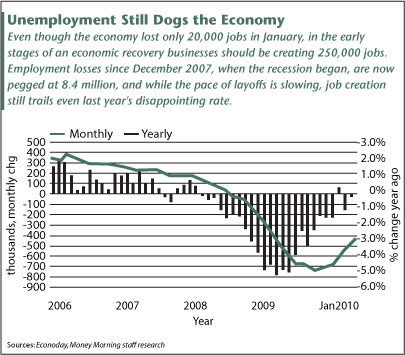Markets rebounded strongly this week. In the process, most of the major market equity averages, commodity indices, and bond ETFs recouped January’s declines and are now back close to their December 31, 2009 levels. What happened?
Welcome to our Sense on Cents Week in Review where I provide a streamlined recap of the major economic data and news, along with month-to-date market returns.
ECONOMIC DATA
A lot of news and data this week. Some good. Some not so good. Let’s dive right in.
1. Industrial and manufacturing data were definite positives. The New York State Manufacturing Index rose to 24.91 versus an expected reading of 18 and a prior month’s reading of 15.
Industrial production increased by .9 versus an expected reading of .8. Last month’s reading was revised higher from .6 to .7.
The Philadelphia Fed Manufacturing Survey increased to 17.6 from a consensus expectation of 17.0 and a prior month’s reading of 15.2.
2. Housing starts were mixed with groundbreaking for new homes increasing while permits declined. With mortgage delinquencies continuing to increase, this sector continues to face an uphill climb. Obama is committing another $1.5 billion in federal funding for the hardest hit markets.
3. Jobless claims very disappointingly ratcheted right back up by 43k to 473k. When will companies start to rehire? THIS STATISTIC REMAINS the GREATEST NEED and the GREATEST CHALLENGE!!
4. Leading Economic Indicators disappointed by registering a .3 reading from last month’s .5 level.
5. Inflation news is also a mixed bag. Increasing fuel and energy costs drove the Producer Price Index higher by 1.4%. The Consumer Price Index, up .2, also felt the higher energy costs but benefited from lower costs for shelter. That is a plus if you are a renter, but not if you are a landlord or homeowner.
The following market statistics are the weekly close (February 19th) versus January’s close and the subsequent month-to-date returns:
U.S. DOLLAR
$/Yen: 91.52 vs 90.19, +1.5%
Euro/Dollar: 1.361 vs 1.386, -1.8%
U.S. Dollar Index: 80.55 vs 79.48, +1.3%
Commentary: the overall U.S. Dollar Index continued to firm on the week, supported by the surprising rise in the discount rate by the Fed. The surprise was not in the actual move by the Fed, but by the timing inter-meeting. The Euro is near 9-month lows to the dollar on the back of the continuing fiscal drama, if not disaster, being played out in Greece. The dollar remains the safe haven . . . for now.
COMMODITIES
Oil: $80.07/barrel vs $72.64, +10.02% !!
Gold: $1119/oz. vs $1081.7, +3.4%
Copper: $3.36 vs $3.10, +8.4%
DJ-UBS Commodity Index: 134.84 vs 129.05, +4.5%
Commentary: commodities rebounded strongly on the week. The overall DJ-UBS Commodity Index was up 4.5%, led by copper which rallied close to 7% and is now back to unchanged on the year. What drove the action in this sector? Indications of a pickup in the industrial sectors both here at home and abroad. In speaking with a friend involved in the shipping business, he confirmed that activity has definitely picked up. The risks remain whether activity can be sustained in the face of tighter monetary policies (that is, rising rates) here and abroad.
EQUITIES
DJIA: 10,402 vs 10,067, +3.3%
Nasdaq: 2244 vs 2147,+4.5%
S&P 500: 1109 vs 1074, +3.3%
MSCI Emerging Mkt Index: 943 vs 940, +.3%
DJ Global ex U.S.: 191 vs 191.9, -.5%
Commentary: a solid week for our domestic equity markets have now brought these averages back very close to unchanged on the year. Emerging and international markets remain down approximately 4-5% for the year given concerns both in the Euro-zone and prospects for higher rates in Asia. Overall performance for the month remains impressive given those overseas developments. What is supporting the equity markets? Overall positive earnings reports. Can these earnings be sustained? Will they lead to job growth? Will economic traction gain a foothold before being limited by the inevitability of higher rates?
BONDS/INTEREST RATES
2yr Treasury: .92% vs .82%, +10 basis points or -.10% (rates up, bond prices down)
10yr Treasury: 3.78% vs 3.59%, +19 basis points or +.19%
COY (High Yield): 6.84 vs 6.81 +.4%
FMY (Mortgage): 18.40 vs 18.62, -.4%
ITE (Government): 57.78 vs 57.83, -0.5%
NXR (Municipal): 14.22 vs 14.33, -1.3%
Commentary: interest rates moved higher this week. Why? A rebound in the equity and commodity markets given positive industrial news and earnings news. The Fed has repeated it will continue to hold its Fed Funds target at 0-.25% for an extended period, but after the surprise inter-meeting move by the Fed to raise its discount rate, some market participants now believe the Fed will raise the Fed Funds rate sooner rather than later. There are some pressures within the municipal space given increased refinancing risks of many municipalities in the face of severe budgetary pressures and declining tax revenues.
SUMMARY/CONCLUSION
The rollercoaster continues. The January declines - both in the markets and along our economic landscape - have been met by a nice upswing in February. What are we to make of it? Well, I hope you are strapped in for a long ride filled with ongoing fits and starts, twists and turns, ups and downs on both Wall Street and more importantly Main Street.
I will do my best to point out both the pitfalls and potential positives along the way. Please help our collective effort by sharing news and developments from your own corners of the world. Together, we can all most effectively navigate the economic landscape.













